Abstract
The presence of Streptococcus pneumoniae in the upper respiratory tract was studied in 318 Filipino children less than 5 years old with an acute lower respiratory tract infection. Nasopharyngeal samples were obtained from 292 children. With both quantitative bacterial culture and detection of capsular polysaccharide antigens by coagglutination, counterimmunoelectrophoresis, and latex agglutination, pneumococci were found in 160 (70%) of the 227 samples eligible for analysis. Culture was positive in 115 samples and antigen was positive in 140 samples. The culture isolation rate was significantly lower if the patient had received antimicrobial agents in the 48 h prior to the sampling. The seven most common types or groups of pneumococci were 6, 14, 19, 23, 15, 7, and 11, which together accounted for 64% of all pneumococcal findings.
Full text
PDF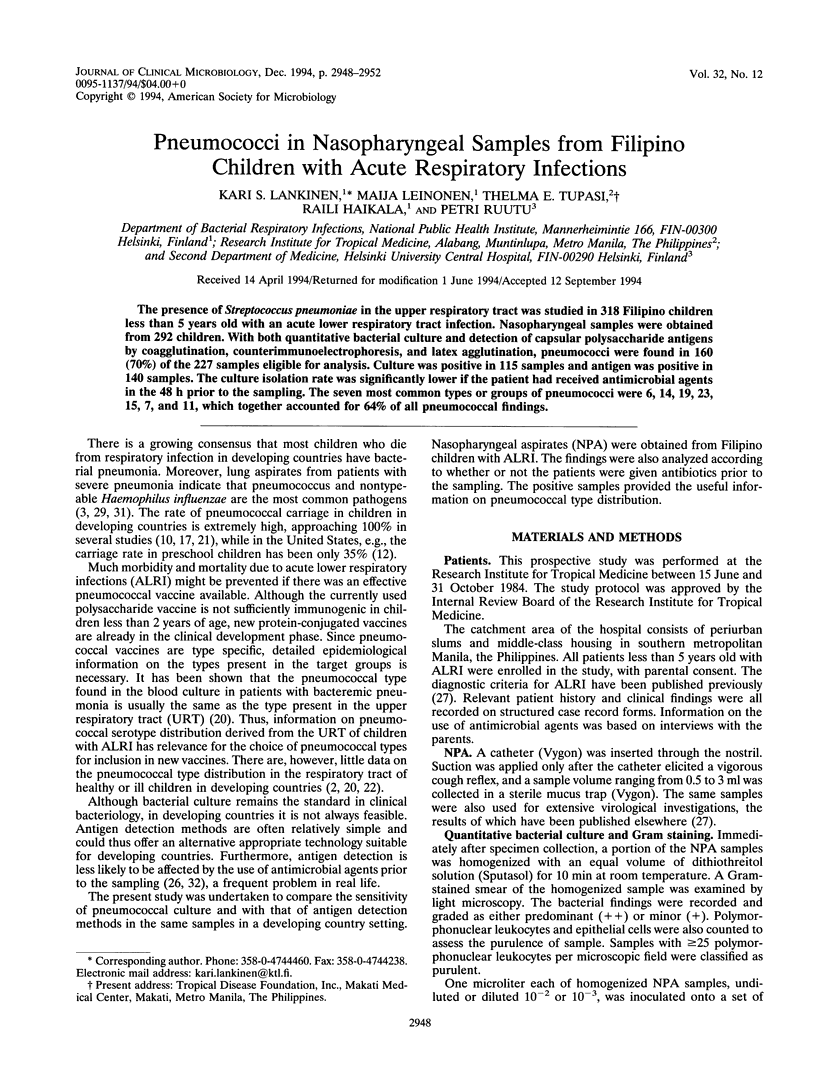
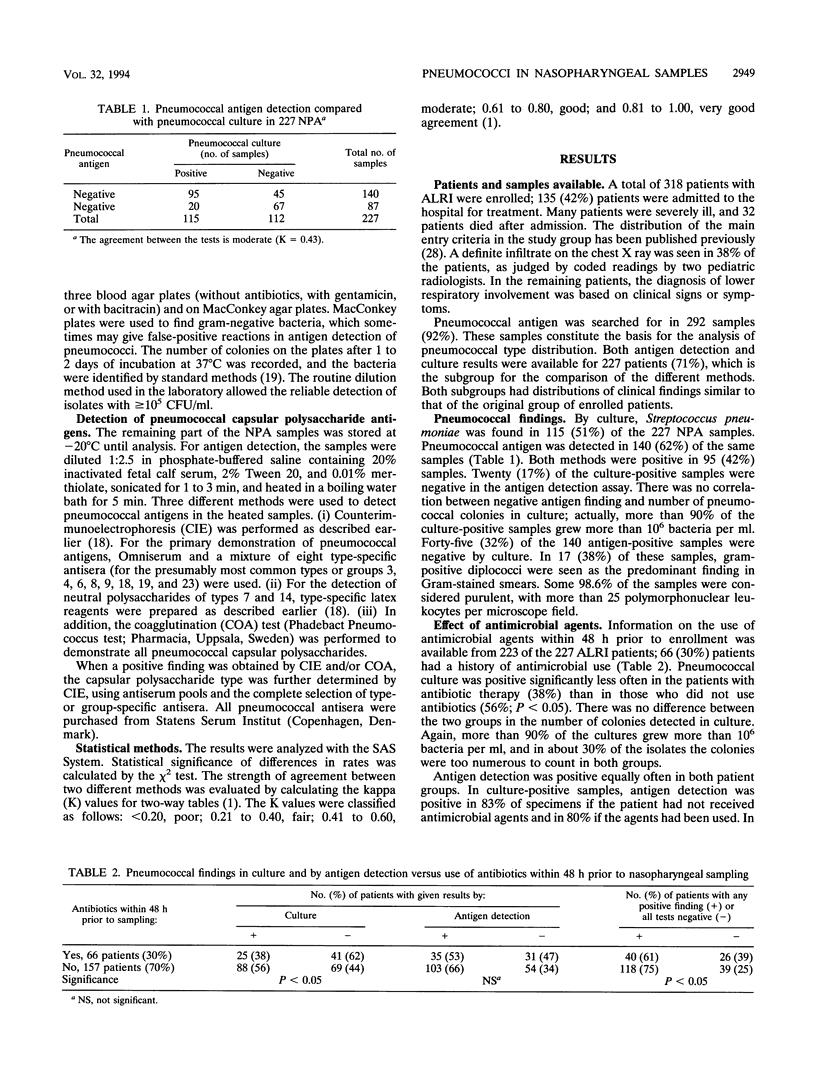
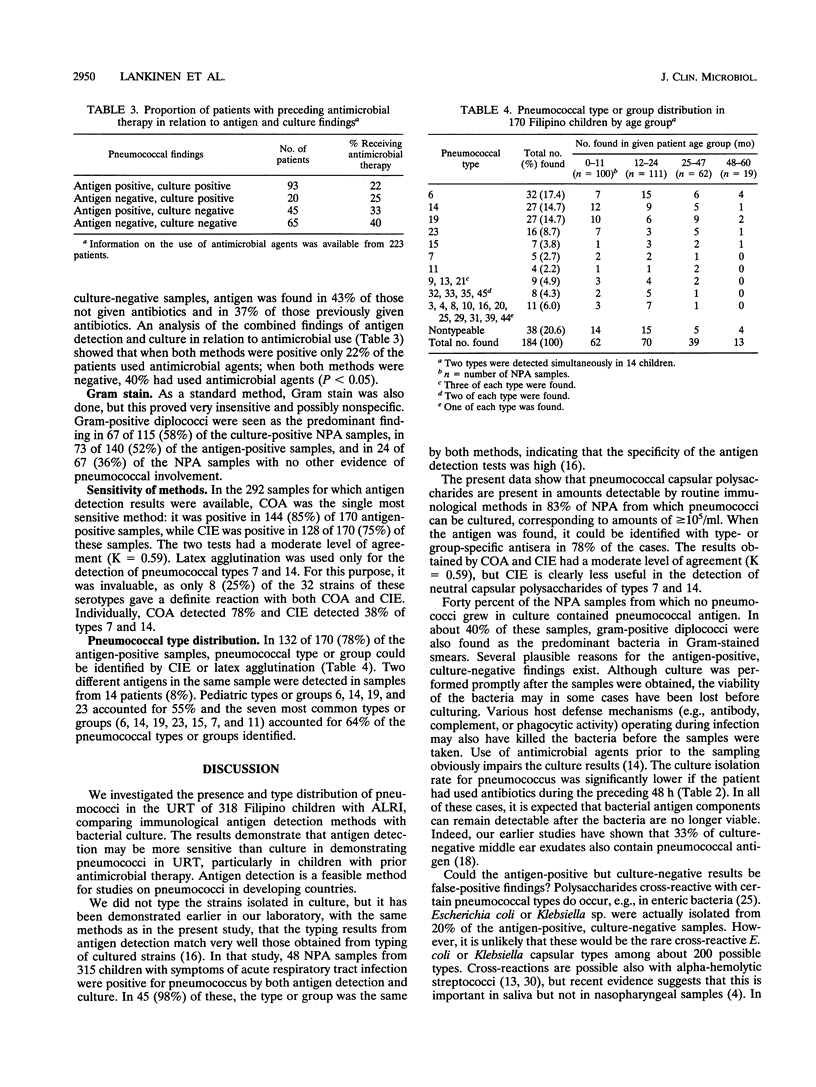
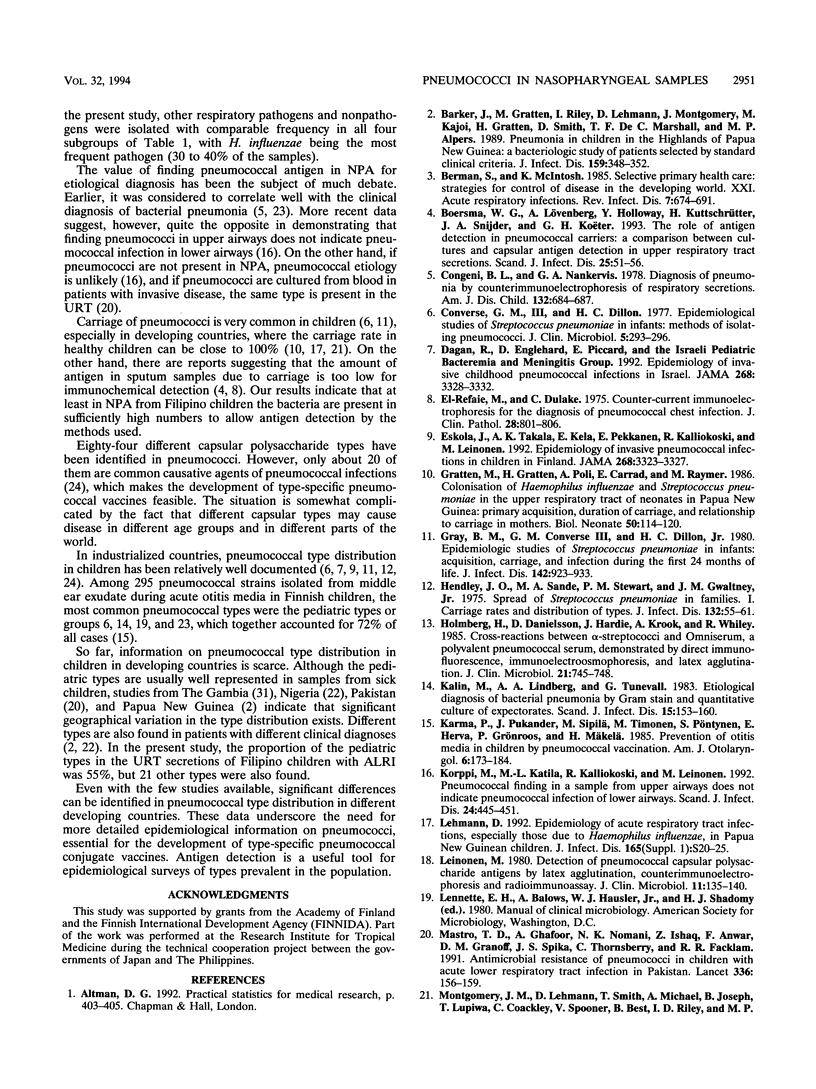
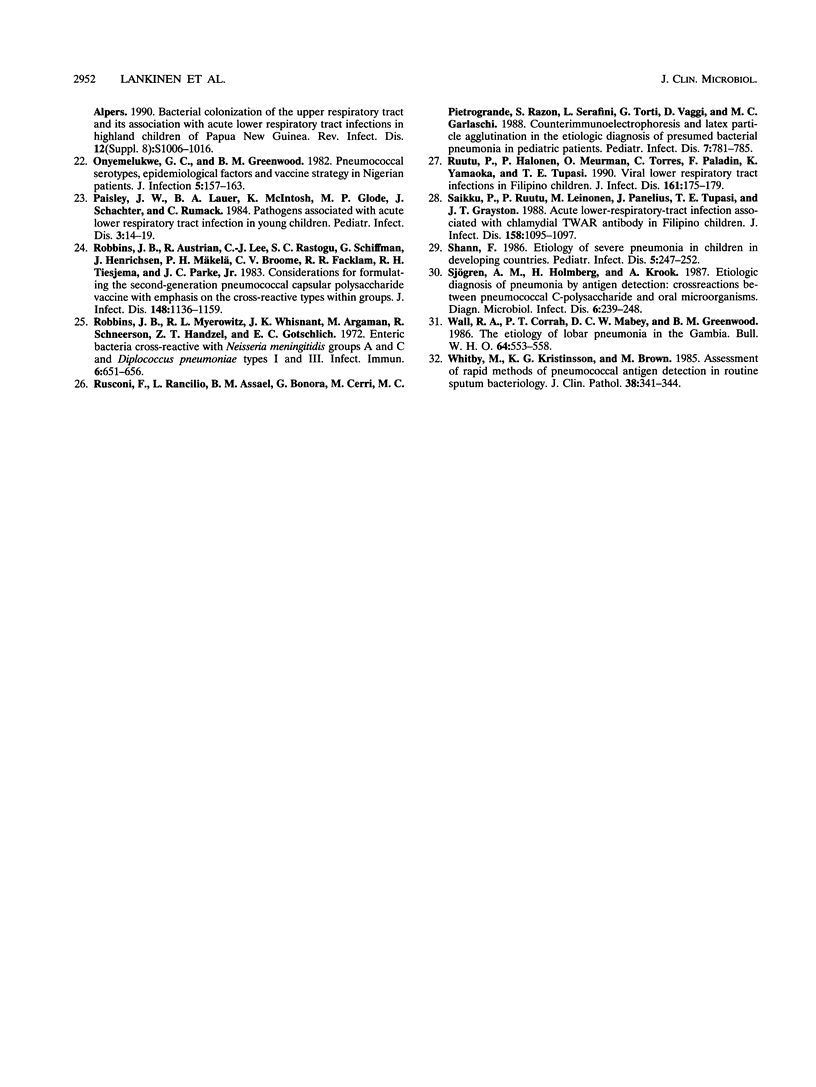
Selected References
These references are in PubMed. This may not be the complete list of references from this article.
- Barker J., Gratten M., Riley I., Lehmann D., Montgomery J., Kajoi M., Gratten H., Smith D., Marshall T. F., Alpers M. P. Pneumonia in children in the Eastern Highlands of Papua New Guinea: a bacteriologic study of patients selected by standard clinical criteria. J Infect Dis. 1989 Feb;159(2):348–352. doi: 10.1093/infdis/159.2.348. [DOI] [PubMed] [Google Scholar]
- Berman S., McIntosh K. Selective primary health care: strategies for control of disease in the developing world. XXI. Acute respiratory infections. Rev Infect Dis. 1985 Sep-Oct;7(5):674–691. doi: 10.1093/clinids/7.5.674. [DOI] [PubMed] [Google Scholar]
- Boersma W. G., Löwenberg A., Holloway Y., Kuttschrütter H., Snijder J. A., Koëter H. The role of antigen detection in pneumococcal carriers: a comparison between cultures and capsular antigen detection in upper respiratory tract secretions. Scand J Infect Dis. 1993;25(1):51–56. [PubMed] [Google Scholar]
- Congeni B. L., Nankervis G. A. Diagnosis of pneumonia by counterimmunoelectrophoresis of respiratory secretions. Am J Dis Child. 1978 Jul;132(7):684–687. doi: 10.1001/archpedi.1978.02120320044010. [DOI] [PubMed] [Google Scholar]
- Converse G. M., 3rd, Dillon H. C., Jr Epidemiological studies of Streptococcus pneumoniae in infants: methods of isolating pneumococci. J Clin Microbiol. 1977 Mar;5(3):293–296. doi: 10.1128/jcm.5.3.293-296.1977. [DOI] [PMC free article] [PubMed] [Google Scholar]
- Dagan R., Engelhard D., Piccard E., Englehard D [corrected to Engelhard D. ]. Epidemiology of invasive childhood pneumococcal infections in Israel. The Israeli Pediatric Bacteremia and Meningitis Group. JAMA. 1992 Dec 16;268(23):3328–3332. [PubMed] [Google Scholar]
- El-Refaie M., Dulake C. Counter-current immunoelectrophoresis for the diagnosis of pneumococcal chest infection. J Clin Pathol. 1975 Oct;28(10):801–806. doi: 10.1136/jcp.28.10.801. [DOI] [PMC free article] [PubMed] [Google Scholar]
- Eskola J., Takala A. K., Kela E., Pekkanen E., Kalliokoski R., Leinonen M. Epidemiology of invasive pneumococcal infections in children in Finland. JAMA. 1992 Dec 16;268(23):3323–3327. [PubMed] [Google Scholar]
- Gratten M., Gratten H., Poli A., Carrad E., Raymer M., Koki G. Colonisation of Haemophilus influenzae and Streptococcus pneumoniae in the upper respiratory tract of neonates in Papua New Guinea: primary acquisition, duration of carriage, and relationship to carriage in mothers. Biol Neonate. 1986;50(2):114–120. doi: 10.1159/000242576. [DOI] [PubMed] [Google Scholar]
- Gray B. M., Converse G. M., 3rd, Dillon H. C., Jr Epidemiologic studies of Streptococcus pneumoniae in infants: acquisition, carriage, and infection during the first 24 months of life. J Infect Dis. 1980 Dec;142(6):923–933. doi: 10.1093/infdis/142.6.923. [DOI] [PubMed] [Google Scholar]
- Hendley J. O., Sande M. A., Stewart P. M., Gwaltney J. M., Jr Spread of Streptococcus pneumoniae in families. I. Carriage rates and distribution of types. J Infect Dis. 1975 Jul;132(1):55–61. doi: 10.1093/infdis/132.1.55. [DOI] [PubMed] [Google Scholar]
- Holmberg H., Danielsson D., Hardie J., Krook A., Whiley R. Cross-reactions between alpha-streptococci and Omniserum, a polyvalent pneumococcal serum, demonstrated by direct immunofluorescence, immunoelectroosmophoresis, and latex agglutination. J Clin Microbiol. 1985 May;21(5):745–748. doi: 10.1128/jcm.21.5.745-748.1985. [DOI] [PMC free article] [PubMed] [Google Scholar]
- Kalin M., Lindberg A. A., Tunevall G. Etiological diagnosis of bacterial pneumonia by gram stain and quantitative culture of expectorates. Leukocytes or alveolar macrophages as indicators of sample representativity. Scand J Infect Dis. 1983;15(2):153–160. doi: 10.3109/inf.1983.15.issue-2.05. [DOI] [PubMed] [Google Scholar]
- Karma P., Pukander J., Sipilä M., Timonen M., Pöntynen S., Herva E., Grönroos P., Mäkelä H. Prevention of otitis media in children by pneumococcal vaccination. Am J Otolaryngol. 1985 May-Jun;6(3):173–184. doi: 10.1016/s0196-0709(85)80081-8. [DOI] [PubMed] [Google Scholar]
- Korppi M., Katila M. L., Kalliokoski R., Leinonen M. Pneumococcal finding in a sample from upper airways does not indicate pneumococcal infection of lower airways. Scand J Infect Dis. 1992;24(4):445–451. doi: 10.3109/00365549209052630. [DOI] [PubMed] [Google Scholar]
- Lehmann D. Epidemiology of acute respiratory tract infections, especially those due to Haemophilus influenzae, in Papua New Guinean children. J Infect Dis. 1992 Jun;165 (Suppl 1):S20–S25. doi: 10.1093/infdis/165-supplement_1-s20. [DOI] [PubMed] [Google Scholar]
- Leinonen M. K. Detection of Pneumococcal Capsular polysaccharide antigens by latex agglutination, counterimmunoelectrophoresis, and radioimmunoassay in middle ear exudates in acute otitis media. J Clin Microbiol. 1980 Feb;11(2):135–140. doi: 10.1128/jcm.11.2.135-140.1980. [DOI] [PMC free article] [PubMed] [Google Scholar]
- Mastro T. D., Ghafoor A., Nomani N. K., Ishaq Z., Anwar F., Granoff D. M., Spika J. S., Thornsberry C., Facklam R. R. Antimicrobial resistance of pneumococci in children with acute lower respiratory tract infection in Pakistan. Lancet. 1991 Jan 19;337(8734):156–159. doi: 10.1016/0140-6736(91)90813-5. [DOI] [PubMed] [Google Scholar]
- Paisley J. W., Lauer B. A., McIntosh K., Glode M. P., Schachter J., Rumack C. Pathogens associated with acute lower respiratory tract infection in young children. Pediatr Infect Dis. 1984 Jan-Feb;3(1):14–19. doi: 10.1097/00006454-198401000-00005. [DOI] [PubMed] [Google Scholar]
- Robbins J. B., Austrian R., Lee C. J., Rastogi S. C., Schiffman G., Henrichsen J., Mäkelä P. H., Broome C. V., Facklam R. R., Tiesjema R. H. Considerations for formulating the second-generation pneumococcal capsular polysaccharide vaccine with emphasis on the cross-reactive types within groups. J Infect Dis. 1983 Dec;148(6):1136–1159. doi: 10.1093/infdis/148.6.1136. [DOI] [PubMed] [Google Scholar]
- Robbins J. B., Myerowitz L., Whisnant J. K., Argaman M., Schneerson R., Handzel Z. T., Gotschlich E. C. Enteric bacteria cross-reactive with Neisseria meningitidis groups A and C and Diplococcus pneumoniae types I and 3. Infect Immun. 1972 Nov;6(5):651–656. doi: 10.1128/iai.6.5.651-656.1972. [DOI] [PMC free article] [PubMed] [Google Scholar]
- Rusconi F., Rancilio L., Assael B. M., Bonora G., Cerri M., Pietrogrande M. C., Razon S., Serafini L., Torti G., Vaggi D. Counterimmunoelectrophoresis and latex particle agglutination in the etiologic diagnosis of presumed bacterial pneumonia in pediatric patients. Pediatr Infect Dis J. 1988 Nov;7(11):781–785. doi: 10.1097/00006454-198811000-00007. [DOI] [PubMed] [Google Scholar]
- Ruutu P., Halonen P., Meurman O., Torres C., Paladin F., Yamaoka K., Tupasi T. E. Viral lower respiratory tract infections in Filipino children. J Infect Dis. 1990 Feb;161(2):175–179. doi: 10.1093/infdis/161.2.175. [DOI] [PubMed] [Google Scholar]
- Saikku P., Ruutu P., Leinonen M., Panelius J., Tupasi T. E., Grayston J. T. Acute lower-respiratory-tract infection associated with chlamydial TWAR antibody in Filipino children. J Infect Dis. 1988 Nov;158(5):1095–1097. doi: 10.1093/infdis/158.5.1095. [DOI] [PubMed] [Google Scholar]
- Shann F. Etiology of severe pneumonia in children in developing countries. Pediatr Infect Dis. 1986 Mar-Apr;5(2):247–252. doi: 10.1097/00006454-198603000-00017. [DOI] [PubMed] [Google Scholar]
- Sjögren A. M., Holmberg H., Krook A. Etiologic diagnosis of pneumonia by antigen detection: crossreactions between pneumococcal C-polysaccharide and oral microorganisms. Diagn Microbiol Infect Dis. 1987 Mar;6(3):239–248. doi: 10.1016/0732-8893(87)90018-6. [DOI] [PubMed] [Google Scholar]
- Wall R. A., Corrah P. T., Mabey D. C., Greenwood B. M. The etiology of lobar pneumonia in the Gambia. Bull World Health Organ. 1986;64(4):553–558. [PMC free article] [PubMed] [Google Scholar]
- Whitby M., Kristinsson K. G., Brown M. Assessment of rapid methods of pneumococcal antigen detection in routine sputum bacteriology. J Clin Pathol. 1985 Mar;38(3):341–344. doi: 10.1136/jcp.38.3.341. [DOI] [PMC free article] [PubMed] [Google Scholar]


